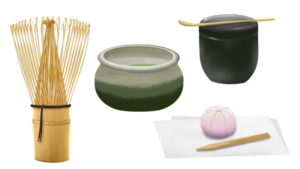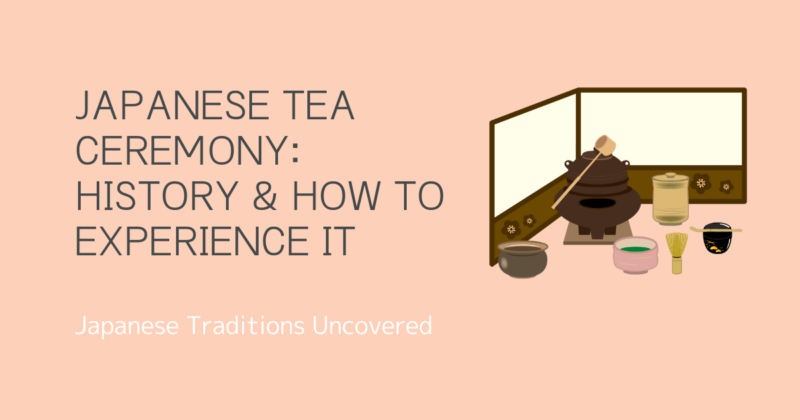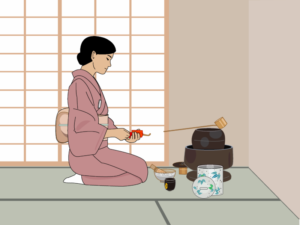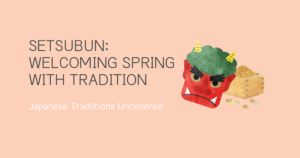1. What Is the Japanese Tea Ceremony?
The Japanese tea ceremony (sado or chanoyu) is one of Japan’s most celebrated traditional arts, where matcha (powdered green tea) is carefully prepared and served to guests in a ceremonial setting. More than just a way to drink tea, it embodies harmony, respect, purity, and tranquility—core values of Japanese culture.
✔ A symbol of Japanese tradition and hospitality
✔ Deeply connected to Zen philosophy
✔ Featured in the Emmy Award-winning drama “SHOGUN,” showcasing its historical significance
But how did this intricate ritual develop? And how can you experience it for yourself? Let’s explore the history, traditions, and modern-day relevance of the Japanese tea ceremony.
2. The History of the Japanese Tea Ceremony
(1) Origins: Tea’s Arrival in Japan (8th Century)
Tea was originally brought to Japan from China in the 8th century by Buddhist monks. It was first consumed as a medicinal drink in Buddhist temples.
(2) The Samurai and Zen Buddhism (12th-14th Century)
By the 12th century, the Zen monk Eisai introduced matcha powdered tea, which became popular among the samurai class. The tea-drinking practice was deeply influenced by Zen philosophy, emphasizing mindfulness and simplicity.
(3) Sen no Rikyu and the Rise of Wabi-Sabi (16th Century)
In the 16th century, Sen no Rikyu refined the Japanese tea ceremony into what it is today. He emphasized “wabi-sabi”—the beauty of simplicity and imperfection—and developed the concept of “wabi-cha”, a minimalistic approach to tea gatherings.
✔ Sen no Rikyu’s influence shaped the tea ceremony into an art form
✔ Even historical figures like Oda Nobunaga and Toyotomi Hideyoshi practiced tea culture
📺 In the drama “SHOGUN,” the tea ceremony is depicted as an essential part of samurai culture, allowing viewers to experience its elegance and discipline.
3. How Does the Japanese Tea Ceremony Work?
Although there are different schools of tea ceremony (such as Urasenke, Omotesenke, and Mushanokōji-senke), the basic structure remains the same.
(1) Entering the Tea Room
- Guests enter the chashitsu (tea room), a tranquil space designed for reflection.
- The entrance is intentionally low, requiring guests to bow as they enter—symbolizing humility and equality.
(2) Preparing the Matcha
- The host carefully prepares matcha using a bamboo whisk (chasen), mixing it with hot water in a tea bowl (chawan).
- Every movement is deliberate, reflecting the ceremony’s meditative nature.

(3) Drinking the Tea
- Guests receive the tea with both hands, rotate the bowl slightly, and take small sips.
- A simple phrase, “Otemae chōdai itashimasu”, is used to express appreciation.
✔ The tea ceremony emphasizes mindfulness, connection, and being present in the moment.
4. The Art of Whisking Matcha – How Froth Enhances Flavor
As an Urasenke-certified tea practitioner, I have learned firsthand how the way you whisk matcha can dramatically affect its taste and texture.
(1) Speed and Pressure Matter
When whisking matcha, you must move the chasen rapidly yet with control. Too much force creates large bubbles, while too little results in weak foam.
✔ “Not too fast, not too slow—finding the right rhythm is key.”
(2) The M-Shaped Motion for Perfect Froth
Using a zig-zag or “M” motion with the whisk ensures even air distribution, creating a smooth and creamy froth. This froth enhances the sweetness of matcha and reduces bitterness.
✔ “A well-made froth brings out the umami and depth of matcha.”
(3) The Final Touch for Elegance
Lifting the whisk gently at the end leaves a beautifully centered foam, a subtle touch that enhances the aesthetics of the tea.
✔ “In tea ceremony, not just taste, but presentation is equally important.”

スポンサーリンク
5. How Tea Culture Continues in Modern Japan
While the Japanese tea ceremony is no longer a daily practice for most Japanese people, it still plays an important role in education and cultural preservation.
(1) Tea Ceremony Clubs in Japanese High Schools
Many Japanese high schools have tea ceremony clubs (sadōbu), where students learn traditional tea-making techniques.
✔ Students practice proper etiquette, posture, and tea preparation skills.
✔ Experienced tea masters visit schools to provide guidance.
(2) School Festivals & Tea Events
During annual school festivals, tea club members host tea gatherings, where visitors can experience matcha and wagashi (Japanese sweets) in a casual setting.
✔ These events allow people to enjoy tea ceremony in a relaxed atmosphere.
✔ Even young students contribute to preserving Japan’s tea culture!

6. Where to Experience the Japanese Tea Ceremony
Whether in Japan or abroad, there are many places to experience the Japanese tea ceremony firsthand.
(1) Best Places to Experience Tea Ceremony in Japan
✔ Kyoto – Urasenke tea houses, traditional temples, and Gion’s historic tea rooms
✔ Tokyo – Cultural experience centers in Asakusa, Omotesando, and Shinjuku
(2) Japanese Tea Ceremony Experiences Outside Japan
✔ Japanese cultural centers in the U.S., Europe, and Asia offer tea workshops.
✔ Universities with Japanese studies programs often host tea ceremony demonstrations.
7. Conclusion – The Timeless Beauty of the Japanese Tea Ceremony
The Japanese tea ceremony is not just about drinking tea—it is a deeply meaningful cultural practice that reflects Japanese aesthetics, mindfulness, and hospitality.
✔ Rooted in Zen Buddhism, promoting mindfulness and simplicity
✔ Still practiced in schools and cultural events across Japan
✔ Featured in the Emmy Award-winning drama “SHOGUN,” bringing historical tea culture to a global audience
✔ Accessible worldwide through tea houses, workshops, and cultural centers
Are you ready to experience the Japanese tea ceremony for yourself?


